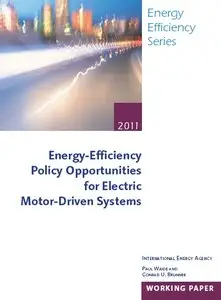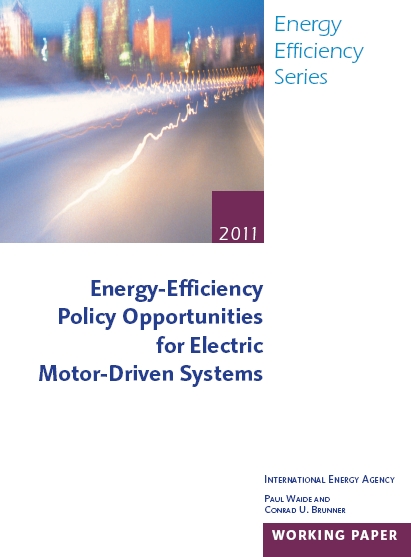"Energy-Efficiency Policy Opportunities for Electric Motor-Driven Systems" by Paul Waide, Conrad U. Brunner
IEA Energy Papers No: 2011/07
OECD / IEA | 2011 | ISSN : 2079-2581 | 132 pages | PDF | 3 MB
IEA Energy Papers No: 2011/07
OECD / IEA | 2011 | ISSN : 2079-2581 | 132 pages | PDF | 3 MB
This paper is the first global analysis of the potential energy savings which could be found in electric motor- driven system (EMDS). EMDS currently accounts for more than 40% of global electricity consumption. Huge untapped energy efficiency potential was found in EMDS; around 25 % of EMDS electricity use could be saved cost-effectively, which would reduce total global electricity demand by about 10%.
To date, energy efficiency opportunities with EMDS have been relatively neglected in comparison with other sustainable energy opportunities. It is crucial to scale up operations and resources committed to realizing the vast potential energy savings and this paper proposes a comprehensive package of policy recommendations to help governments achieve these significant energy savings in EMDS.
Table of Contents
Acknowledgments
Executive Summary
The global assessment
Motor systems used widely across all sectors
Policy intervention can stimulate significant savings
Policies needed for optimising packaged systems
Comprehensive integrated policy package
Regulatory policy measures
Non regulatory policy measures
Putting ideas into practice
1. Introduction
2. Electric Motor Driven Systems and Applications
Motor system types and definitions
EMDS Applications
Motor market data
Market volumes by application
Market share by efficiency
Market penetration of VFD technology
3. Global Electricity Consumption and CO2 Emissions of Electric Motor-Driven Systems
Scope and methodology
Scope and definitions.
Methodology
Top down estimates of electricity use
Demand by end use
Demand by motor sector
Demand by motor size
Demand by motor application
Conclusions from top down estimates
Bottom up model of motor electricity use
Methodology
The motor stock model
Estimates from bottom up model
Consolidated top-down and bottom up estimates of electricity consumption
and CO2 emissions
Causes of uncertainty
Top down estimates
Bottom up estimates
4. Energy-Savings Technologies and Savings Potentials Applicable to Electric
Motor Driven Systems
Improving component efficiency
Standard AC squirrel-cage induction motor
Other motor technologies
New motor technologies
Gears and transmissions
Motor control technologies
Variable loads and VFDs or ASDs
Efficiency opportunities in different motor applications
Pumps
Fans
Compressors
Other applications
Related energy-savings opportunities
Engineering practice improvement
Integrated machine design
Packaged products as core motor systems
Adequate sizing
Efficient operation
5. The Economics of Energy Savings in Electric Motor-Driven Systems
Factors that influence EMDS economics
Engineering decision making
Least life-cycle cost
Repair versus replacement
Upgrading existing systems
Paying for a better motor by buying a smaller motor
Tapping cost benefits from motor system optimisation
6. Barriers to Optimisation of Efficient Electric Motor-Driven Systems
Concepts of barriers
Missed cost reductions for mass produced products
Barriers to international trade.
Technical barriers in electricity supply
Barriers in non harmonised standards
Barriers at sector and business levels
Barriers at the level of manufacturers and OEMs
Barriers in wholesale, planning and engineering
Barriers at the level of investors and energy managers
Payback period and internal rate of return: risk and profitability analysis
Externalities of electricity use by electric motors and motor systems
Conclusions on removing barriers
6. Energy Efficiency Policy Experience for Electric Motor Driven Systems
Regulations and labelling for integrated equipment and components
Electric motors
Pumps
Fans
Compressors
Systems performance specifications
Electric motors
Pumps
Fans
Air compressors
Tools to encourage adoption of enhanced motor driven systems
United States: pump motor systems
United States: fan motor systems
United States: air compressor systems
Awareness raising efforts
European Union: pumps
Economic incentives
North America
China
Industrial sector energy service companies
Industrial energy efficiency programmes and capacity building
European Union
China
Links with macro policy initiatives
Evaluation and impacts
7. Options and Recommendations for New Policies on Electric Motor Driven Systems
Policy context
Policy recommendations
Regulatory policy measures
Non regulatory policy measures
Potential policy impacts
Comprehensive integrated policy package
Regulatory
Non regulatory
Putting ideas into practice
Annex A. Technical Standards for EMDS
Abbreviations
References
with TOC BookMarkLinks
More : You find here



